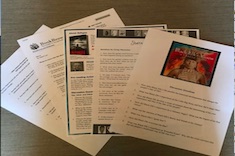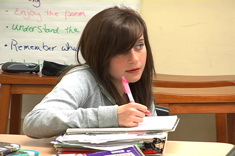CCSS.ELA-LITERACY.CCRA.W.5
With guidance and support from peers and adults, develop and strengthen writing as needed by planning, revising, editing, rewriting, or trying a new approach.
Teachers are often waging a small mental battle with tensions in our teaching: Something isn’t working quite right, and our minds are preoccupied with finding a solution. This past year, I was wrestling with how to help fifth-grade students develop a genuine sense of audience for their multigenre writing. I was happy with the way a multigenre approach improved students’ commitment to a topic and developed their ability to see an idea from different perspectives, but I wanted my writers to imagine their finished products as something an “outsider” (not just me and their peers) would be truly engaged in reading.
Writing a readers’ guide, I thought, might accomplish that goal. What do questions on a readers’ guide do? They force writers to locate a “discussable” in their writing, something without a right or wrong answer, for readers to consider and discuss.
Below is a description of the steps I took in my inaugural attempt to help intermediate-grade writers deepen their awareness of a reading audience by learning to write readers’ guide questions. Most students are familiar with those lists of questions that appear at the end of some chapter books, such as those in Refugee, Savvy, and Hello, Universe.
To prepare, I photocopy a bunch of readers’ guides for narrative and informational texts—some that I’ve read aloud to the class and some that students have read on their own. Each student gets a stack of five readers’ guides to work with.
Before I pass out the examples, I use our whiteboard to project examples of readers’ guides from books we’re all familiar with. I ask students to look for words and phrases that steer readers to think in a certain direction, language we call think about this words. As students call out the think about this language they notice, I highlight it on the projected copy.
We notice that some think about this language asks readers to name a fact shared in the text and some asks them to consider a question without one right or wrong answer. We come back to this distinction later in the lesson. For now, we’re occupied with recording specific words—see the chart below—that we recognize as prompting any kind of reflection on a text.
|
Title of Book |
Readers’ Guide Question # |
Word #1 |
Word #2 |
Word #3 |
|
Savvy |
1 |
Why |
What |
|
|
Savvy |
7 |
Explain |
Give |
|
|
Hello, Universe |
5 |
How |
Is |
Consider |
|
Hello, Universe |
8 |
How |
How |
Consider |
|
Refugee |
8 |
Who |
Why |
How |
|
Refugee |
11 |
Compare |
Compare |
When our guided practice segment shows me that students are noticing think about this words and classifying them accurately, I pass out the packets of readers’ guides and ask students to work independently, reading through the questions and highlighting the words they think direct readers how to think about the book. Students record the words they highlighted on a blank copy of the chart we used in guided practice.
|
What to do: In the columns below, record the “think about this” words from two questions in each of the readers’ guides in your pile. You’ll notice that some questions have many “think about this” tasks piled together, so there’s space to write up to three of those words in the columns below. |
||||
|
Title of Book |
Readers’ Guide Question # |
Word #1 |
Word #2 |
Word #3 |
Next have students in pairs share their completed charts and talk about patterns they notice among the words they’ve highlighted. It does not take long for them to point out that think about this words are verbs, and that a handful of those verbs show up frequently. When we come back together as a group, we chart the “frequent flyers,” words that show up at least twice on more than one readers’ guide. The chart goes on the wall for later use.
From here, it’s a smooth transition from a content analysis of “professional” discussion questions to the possibility of my students developing readers’ guide questions for their own multigenre writing. I explain that one way writers can get closer to the “heart” of their informational writing is to identify what they want readers to think about when they read. We step back for a moment to consider this—the idea that writers often have an audience in mind when they’re writing and that they want that audience to consider some important ideas stitched into their writing.
Figuring out what those stitched-in ideas are is on the upper end of a developmental writing continuum, a challenge that many intermediate writers are ready for, especially with scaffolding in place. With this lesson, the scaffolds are named on our Frequent Flyer chart, the go-to resource students use as they read through one of their multigenre pieces and write a question that includes at least one think about it word for their future reading audience.
We agree that although some think about it language directs readers’ attention to basic facts, we are striving for questions with think about it words that lead readers toward inference, synthesis, and evaluation.
Writing a question with think about it language that prompts explicit versus implicit thinking was a struggle for some of my writers. Below are examples of readers’ guide questions at the end of two multigenre projects that show a writer who “got it” and a writer who needed some reteaching.
From a guide about Ruby Bridges (Got it: The writer has avoided asking basic recall questions, asking solid think about it questions that challenge readers to infer from and evaluate information.)
-
How did you feel when you read the Segregation Do’s and Don’ts section of this multigenre project? Why do you think the author chose this genre to share information about segregation? Do you think this piece accurately describes the outrageous laws that African American citizens had to abide by when Ruby Bridges was a young girl?
From a guide about Pollution (Needs more instruction: The writer has asked basic recall questions rather than think about it questions that prompt readers to go beyond facts.)
-
What city in the world has the worst pollution? Why is pollution so bad here?
Here is a two-step approach for reteaching.
First, ask the writer to answer her own questions and have her notice that in the examples above, finding the city with the worst pollution and telling why the pollution is so bad requires little more than pointing a finger at a place in the text. Remind her that readers’ guide questions demand more from a reader, and then review relevant examples from the guided and independent practice sections of the lesson.
Next, give your writer two verbs that resist the writing of “known-answer” questions (e.g., consider and compare). Have her choose one of the verbs and then work through question writing with your guidance.
Writers take themselves more seriously when they have to read for a sophistication in their work, that is, an idea or two nestled in their text that might go unnoticed, even by the writer, if she wasn’t given time to identify it and tools (those think about it stems) to lift it up.






